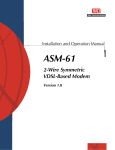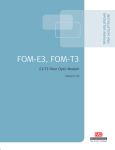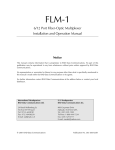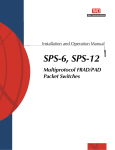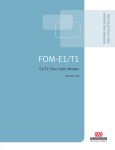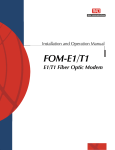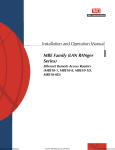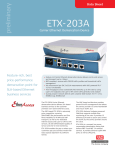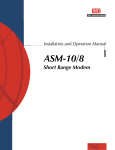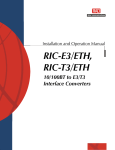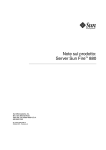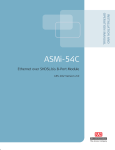Download RAD Data comm ASM-MN-214 Specifications
Transcript
INSTALLATION AND
OPERATION MANUAL
ASM-MN-214
Chassis for Short Range Modems
The Access Company
ASM-MN-214
Chassis for Short Range Modems
Installation and Operation Manual
Notice
This manual contains information that is proprietary to RAD Data Communications Ltd. ("RAD").
No part of this publication may be reproduced in any form whatsoever without prior written
approval by RAD Data Communications.
Right, title and interest, all information, copyrights, patents, know-how, trade secrets and other
intellectual property or other proprietary rights relating to this manual and to the ASM-MN-214
and any software components contained therein are proprietary products of RAD protected
under international copyright law and shall be and remain solely with RAD.
The ASM-MN-214 product name is owned by RAD. No right, license, or interest to such
trademark is granted hereunder, and you agree that no such right, license, or interest shall be
asserted by you with respect to such trademark. The RAD name, logo, logotype, and the terms
EtherAccess, TDMoIP and TDMoIP Driven, and the product names Optimux and IPmux, are
registered trademarks of RAD Data Communications Ltd. All other trademarks are the property of
their respective holders.
You shall not copy, reverse compile or reverse assemble all or any portion of the Manual or the
ASM-MN-214. You are prohibited from, and shall not, directly or indirectly, develop, market,
distribute, license, or sell any product that supports substantially similar functionality as the
ASM-MN-214, based on or derived in any way from the ASM-MN-214. Your undertaking in this
paragraph shall survive the termination of this Agreement.
This Agreement is effective upon your opening of the ASM-MN-214 package and shall continue
until terminated. RAD may terminate this Agreement upon the breach by you of any term hereof.
Upon such termination by RAD, you agree to return to RAD the ASM-MN-214 and all copies and
portions thereof.
For further information contact RAD at the address below or contact your local distributor.
International Headquarters
RAD Data Communications Ltd.
North America Headquarters
RAD Data Communications Inc.
24 Raoul Wallenberg Street
Tel Aviv 69719, Israel
Tel: 972-3-6458181
Fax: 972-3-6498250, 6474436
E-mail: [email protected]
900 Corporate Drive
Mahwah, NJ 07430, USA
Tel: (201) 5291100, Toll free: 1-800-4447234
Fax: (201) 5295777
E-mail: [email protected]
© 1989–2008 RAD Data Communications Ltd.
Publication No. 609-200-03/08
Limited Warranty
RAD warrants to DISTRIBUTOR that the hardware in the ASM-MN-214 to be delivered hereunder
shall be free of defects in material and workmanship under normal use and service for a period
of twelve (12) months following the date of shipment to DISTRIBUTOR.
If, during the warranty period, any component part of the equipment becomes defective by
reason of material or workmanship, and DISTRIBUTOR immediately notifies RAD of such defect,
RAD shall have the option to choose the appropriate corrective action: a) supply a replacement
part, or b) request return of equipment to its plant for repair, or c) perform necessary repair at
the equipment's location. In the event that RAD requests the return of equipment, each party
shall pay one-way shipping costs.
RAD shall be released from all obligations under its warranty in the event that the equipment has
been subjected to misuse, neglect, accident or improper installation, or if repairs or
modifications were made by persons other than RAD's own authorized service personnel, unless
such repairs by others were made with the written consent of RAD.
The above warranty is in lieu of all other warranties, expressed or implied. There are no
warranties which extend beyond the face hereof, including, but not limited to, warranties of
merchantability and fitness for a particular purpose, and in no event shall RAD be liable for
consequential damages.
RAD shall not be liable to any person for any special or indirect damages, including, but not
limited to, lost profits from any cause whatsoever arising from or in any way connected with the
manufacture, sale, handling, repair, maintenance or use of the ASM-MN-214, and in no event
shall RAD's liability exceed the purchase price of the ASM-MN-214.
DISTRIBUTOR shall be responsible to its customers for any and all warranties which it makes
relating to ASM-MN-214 and for ensuring that replacements and other adjustments required in
connection with the said warranties are satisfactory.
Software components in the ASM-MN-214 are provided "as is" and without warranty of any kind.
RAD disclaims all warranties including the implied warranties of merchantability and fitness for a
particular purpose. RAD shall not be liable for any loss of use, interruption of business or
indirect, special, incidental or consequential damages of any kind. In spite of the above RAD
shall do its best to provide error-free software products and shall offer free Software updates
during the warranty period under this Agreement.
RAD's cumulative liability to you or any other party for any loss or damages resulting from any
claims, demands, or actions arising out of or relating to this Agreement and the ASM-MN-214
shall not exceed the sum paid to RAD for the purchase of the ASM-MN-214. In no event shall
RAD be liable for any indirect, incidental, consequential, special, or exemplary damages or lost
profits, even if RAD has been advised of the possibility of such damages.
This Agreement shall be construed and governed in accordance with the laws of the State of
Israel.
Product Disposal
To facilitate the reuse, recycling and other forms of recovery of waste
equipment in protecting the environment, the owner of this RAD product is
required to refrain from disposing of this product as unsorted municipal
waste at the end of its life cycle. Upon termination of the unit’s use,
customers should provide for its collection for reuse, recycling or other form
of environmentally conscientious disposal.
General Safety Instructions
The following instructions serve as a general guide for the safe installation and operation of
telecommunications products. Additional instructions, if applicable, are included inside the
manual.
Safety Symbols
This symbol may appear on the equipment or in the text. It indicates potential
safety hazards regarding product operation or maintenance to operator or service
personnel.
Warning
Danger of electric shock! Avoid any contact with the marked surface while the
product is energized or connected to outdoor telecommunication lines.
Protective ground: the marked lug or terminal should be connected to the building
protective ground bus.
Warning
Some products may be equipped with a laser diode. In such cases, a label with the
laser class and other warnings as applicable will be attached near the optical
transmitter. The laser warning symbol may be also attached.
Please observe the following precautions:
•
Before turning on the equipment, make sure that the fiber optic cable is intact
and is connected to the transmitter.
•
Do not attempt to adjust the laser drive current.
•
Do not use broken or unterminated fiber-optic cables/connectors or look
straight at the laser beam.
•
The use of optical devices with the equipment will increase eye hazard.
•
Use of controls, adjustments or performing procedures other than those
specified herein, may result in hazardous radiation exposure.
ATTENTION: The laser beam may be invisible!
In some cases, the users may insert their own SFP laser transceivers into the product. Users are
alerted that RAD cannot be held responsible for any damage that may result if non-compliant
transceivers are used. In particular, users are warned to use only agency approved products that
comply with the local laser safety regulations for Class 1 laser products.
Always observe standard safety precautions during installation, operation and maintenance of
this product. Only qualified and authorized service personnel should carry out adjustment,
maintenance or repairs to this product. No installation, adjustment, maintenance or repairs
should be performed by either the operator or the user.
Handling Energized Products
General Safety Practices
Do not touch or tamper with the power supply when the power cord is connected. Line voltages
may be present inside certain products even when the power switch (if installed) is in the OFF
position or a fuse is blown. For DC-powered products, although the voltages levels are usually
not hazardous, energy hazards may still exist.
Before working on equipment connected to power lines or telecommunication lines, remove
jewelry or any other metallic object that may come into contact with energized parts.
Unless otherwise specified, all products are intended to be grounded during normal use.
Grounding is provided by connecting the mains plug to a wall socket with a protective ground
terminal. If a ground lug is provided on the product, it should be connected to the protective
ground at all times, by a wire with a diameter of 18 AWG or wider. Rack-mounted equipment
should be mounted only in grounded racks and cabinets.
Always make the ground connection first and disconnect it last. Do not connect
telecommunication cables to ungrounded equipment. Make sure that all other cables are
disconnected before disconnecting the ground.
Connecting AC Mains
Make sure that the electrical installation complies with local codes.
Always connect the AC plug to a wall socket with a protective ground.
The maximum permissible current capability of the branch distribution circuit that supplies power
to the product is 16A. The circuit breaker in the building installation should have high breaking
capacity and must operate at short-circuit current exceeding 35A.
Always connect the power cord first to the equipment and then to the wall socket. If a power
switch is provided in the equipment, set it to the OFF position. If the power cord cannot be
readily disconnected in case of emergency, make sure that a readily accessible circuit breaker or
emergency switch is installed in the building installation.
In cases when the power distribution system is IT type, the switch must disconnect both poles
simultaneously.
Connecting DC Power
Unless otherwise specified in the manual, the DC input to the equipment is floating in reference
to the ground. Any single pole can be externally grounded.
Due to the high current capability of DC power systems, care should be taken when connecting
the DC supply to avoid short-circuits and fire hazards.
DC units should be installed in a restricted access area, i.e. an area where access is authorized
only to qualified service and maintenance personnel.
Make sure that the DC power supply is electrically isolated from any AC source and that the
installation complies with the local codes.
The maximum permissible current capability of the branch distribution circuit that supplies power
to the product is 16A. The circuit breaker in the building installation should have high breaking
capacity and must operate at short-circuit current exceeding 35A.
Before connecting the DC supply wires, ensure that power is removed from the DC circuit. Locate
the circuit breaker of the panel board that services the equipment and switch it to the OFF
position. When connecting the DC supply wires, first connect the ground wire to the
corresponding terminal, then the positive pole and last the negative pole. Switch the circuit
breaker back to the ON position.
A readily accessible disconnect device that is suitably rated and approved should be incorporated
in the building installation.
If the DC power supply is floating, the switch must disconnect both poles simultaneously.
Connecting Data and Telecommunications Cables
Data and telecommunication interfaces are classified according to their safety status.
The following table lists the status of several standard interfaces. If the status of a given port
differs from the standard one, a notice will be given in the manual.
Ports
Safety Status
V.11, V.28, V.35, V.36, RS-530, X.21,
10 BaseT, 100 BaseT, Unbalanced E1,
E2, E3, STM, DS-2, DS-3, S-Interface
ISDN, Analog voice E&M
SELV
xDSL (without feeding voltage),
Balanced E1, T1, Sub E1/T1
TNV-1 Telecommunication Network Voltage-1:
Ports whose normal operating voltage is within the
limits of SELV, on which overvoltages from
telecommunications networks are possible.
FXS (Foreign Exchange Subscriber)
TNV-2 Telecommunication Network Voltage-2:
Ports whose normal operating voltage exceeds the
limits of SELV (usually up to 120 VDC or telephone
ringing voltages), on which overvoltages from
telecommunication networks are not possible. These
ports are not permitted to be directly connected to
external telephone and data lines.
FXO (Foreign Exchange Office), xDSL
(with feeding voltage), U-Interface
ISDN
TNV-3 Telecommunication Network Voltage-3:
Ports whose normal operating voltage exceeds the
limits of SELV (usually up to 120 VDC or telephone
ringing voltages), on which overvoltages from
telecommunication networks are possible.
Safety Extra Low Voltage:
Ports which do not present a safety hazard. Usually
up to 30 VAC or 60 VDC.
Always connect a given port to a port of the same safety status. If in doubt, seek the assistance
of a qualified safety engineer.
Always make sure that the equipment is grounded before connecting telecommunication cables.
Do not disconnect the ground connection before disconnecting all telecommunications cables.
Some SELV and non-SELV circuits use the same connectors. Use caution when connecting cables.
Extra caution should be exercised during thunderstorms.
When using shielded or coaxial cables, verify that there is a good ground connection at both
ends. The grounding and bonding of the ground connections should comply with the local codes.
The telecommunication wiring in the building may be damaged or present a fire hazard in case of
contact between exposed external wires and the AC power lines. In order to reduce the risk,
there are restrictions on the diameter of wires in the telecom cables, between the equipment
and the mating connectors.
Caution
To reduce the risk of fire, use only No. 26 AWG or larger telecommunication line
cords.
Attention
Pour réduire les risques s’incendie, utiliser seulement des conducteurs de
télécommunications 26 AWG ou de section supérieure.
Some ports are suitable for connection to intra-building or non-exposed wiring or cabling only. In
such cases, a notice will be given in the installation instructions.
Do not attempt to tamper with any carrier-provided equipment or connection hardware.
Electromagnetic Compatibility (EMC)
The equipment is designed and approved to comply with the electromagnetic regulations of
major regulatory bodies. The following instructions may enhance the performance of the
equipment and will provide better protection against excessive emission and better immunity
against disturbances.
A good ground connection is essential. When installing the equipment in a rack, make sure to
remove all traces of paint from the mounting points. Use suitable lock-washers and torque. If an
external grounding lug is provided, connect it to the ground bus using braided wire as short as
possible.
The equipment is designed to comply with EMC requirements when connecting it with unshielded
twisted pair (UTP) cables. However, the use of shielded wires is always recommended, especially
for high-rate data. In some cases, when unshielded wires are used, ferrite cores should be
installed on certain cables. In such cases, special instructions are provided in the manual.
Disconnect all wires which are not in permanent use, such as cables used for one-time
configuration.
The compliance of the equipment with the regulations for conducted emission on the data lines
is dependent on the cable quality. The emission is tested for UTP with 80 dB longitudinal
conversion loss (LCL).
Unless otherwise specified or described in the manual, TNV-1 and TNV-3 ports provide secondary
protection against surges on the data lines. Primary protectors should be provided in the building
installation.
The equipment is designed to provide adequate protection against electro-static discharge (ESD).
However, it is good working practice to use caution when connecting cables terminated with
plastic connectors (without a grounded metal hood, such as flat cables) to sensitive data lines.
Before connecting such cables, discharge yourself by touching ground or wear an ESD preventive
wrist strap.
FCC-15 User Information
This equipment has been tested and found to comply with the limits of the Class A digital device,
pursuant to Part 15 of the FCC rules. These limits are designed to provide reasonable protection
against harmful interference when the equipment is operated in a commercial environment. This
equipment generates, uses and can radiate radio frequency energy and, if not installed and used
in accordance with the Installation and Operation manual, may cause harmful interference to the
radio communications. Operation of this equipment in a residential area is likely to cause harmful
interference in which case the user will be required to correct the interference at his own
expense.
Canadian Emission Requirements
This Class A digital apparatus meets all the requirements of the Canadian Interference-Causing
Equipment Regulation.
Cet appareil numérique de la classe A respecte toutes les exigences du Règlement sur le matériel
brouilleur du Canada.
Warning per EN 55022 (CISPR-22)
Warning
Avertissement
Achtung
This is a class A product. In a domestic environment, this product may cause radio
interference, in which case the user will be required to take adequate measures.
Cet appareil est un appareil de Classe A. Dans un environnement résidentiel, cet
appareil peut provoquer des brouillages radioélectriques. Dans ces cas, il peut être
demandé à l’utilisateur de prendre les mesures appropriées.
Das vorliegende Gerät fällt unter die Funkstörgrenzwertklasse A. In Wohngebieten
können beim Betrieb dieses Gerätes Rundfunkströrungen auftreten, für deren
Behebung der Benutzer verantwortlich ist.
Français
Mise au rebut du produit
Afin de faciliter la réutilisation, le recyclage ainsi que d'autres formes de
récupération d'équipement mis au rebut dans le cadre de la protection de
l'environnement, il est demandé au propriétaire de ce produit RAD de ne pas
mettre ce dernier au rebut en tant que déchet municipal non trié, une fois
que le produit est arrivé en fin de cycle de vie. Le client devrait proposer des
solutions de réutilisation, de recyclage ou toute autre forme de mise au rebut
de cette unité dans un esprit de protection de l'environnement, lorsqu'il aura
fini de l'utiliser.
Instructions générales de sécurité
Les instructions suivantes servent de guide général d'installation et d'opération sécurisées des
produits de télécommunications. Des instructions supplémentaires sont éventuellement
indiquées dans le manuel.
Symboles de sécurité
Ce symbole peut apparaitre sur l'équipement ou dans le texte. Il indique des risques
potentiels de sécurité pour l'opérateur ou le personnel de service, quant à
l'opération du produit ou à sa maintenance.
Avertissement
Danger de choc électrique ! Evitez tout contact avec la surface marquée tant que le
produit est sous tension ou connecté à des lignes externes de télécommunications.
Mise à la terre de protection : la cosse ou la borne marquée devrait être connectée
à la prise de terre de protection du bâtiment.
•
Avant la mise en marche de l'équipement, assurez-vous que le câble de fibre
optique est intact et qu'il est connecté au transmetteur.
•
Ne tentez pas d'ajuster le courant de la commande laser.
•
N'utilisez pas des câbles ou connecteurs de fibre optique cassés ou sans
terminaison et n'observez pas directement un rayon laser.
•
L'usage de périphériques optiques avec l'équipement augmentera le risque pour
les yeux.
•
L'usage de contrôles, ajustages ou procédures autres que celles spécifiées ici
pourrait résulter en une dangereuse exposition aux radiations.
ATTENTION : Le rayon laser peut être invisible !
Les utilisateurs pourront, dans certains cas, insérer leurs propres émetteurs-récepteurs Laser SFP
dans le produit. Les utilisateurs sont avertis que RAD ne pourra pas être tenue responsable de
tout dommage pouvant résulter de l'utilisation d'émetteurs-récepteurs non conformes. Plus
particulièrement, les utilisateurs sont avertis de n'utiliser que des produits approuvés par
l'agence et conformes à la réglementation locale de sécurité laser pour les produits laser de
classe 1.
Respectez toujours les précautions standards de sécurité durant l'installation, l'opération et la
maintenance de ce produit. Seul le personnel de service qualifié et autorisé devrait effectuer
l'ajustage, la maintenance ou les réparations de ce produit. Aucune opération d'installation,
d'ajustage, de maintenance ou de réparation ne devrait être effectuée par l'opérateur ou
l'utilisateur.
Manipuler des produits sous tension
Règles générales de sécurité
Ne pas toucher ou altérer l'alimentation en courant lorsque le câble d'alimentation est branché.
Des tensions de lignes peuvent être présentes dans certains produits, même lorsque le
commutateur (s'il est installé) est en position OFF ou si le fusible est rompu. Pour les produits
alimentés par CC, les niveaux de tension ne sont généralement pas dangereux mais des risques
de courant peuvent toujours exister.
Avant de travailler sur un équipement connecté aux lignes de tension ou de télécommunications,
retirez vos bijoux ou tout autre objet métallique pouvant venir en contact avec les pièces sous
tension.
Sauf s'il en est autrement indiqué, tous les produits sont destinés à être mis à la terre durant
l'usage normal. La mise à la terre est fournie par la connexion de la fiche principale à une prise
murale équipée d'une borne protectrice de mise à la terre. Si une cosse de mise à la terre est
fournie avec le produit, elle devrait être connectée à tout moment à une mise à la terre de
protection par un conducteur de diamètre 18 AWG ou plus. L'équipement monté en châssis ne
devrait être monté que sur des châssis et dans des armoires mises à la terre.
Branchez toujours la mise à la terre en premier et débranchez-la en dernier. Ne branchez pas des
câbles de télécommunications à un équipement qui n'est pas mis à la terre. Assurez-vous que
tous les autres câbles sont débranchés avant de déconnecter la mise à la terre.
Français
Certains produits peuvent être équipés d'une diode laser. Dans de tels cas, une
étiquette indiquant la classe laser ainsi que d'autres avertissements, le cas échéant,
sera jointe près du transmetteur optique. Le symbole d'avertissement laser peut
aussi être joint.
Avertissement
Veuillez observer les précautions suivantes :
Français
Connexion au courant du secteur
Assurez-vous que l'installation électrique est conforme à la réglementation locale.
Branchez toujours la fiche de secteur à une prise murale équipée d'une borne protectrice de mise
à la terre.
La capacité maximale permissible en courant du circuit de distribution de la connexion alimentant
le produit est de 16A. Le coupe-circuit dans l'installation du bâtiment devrait avoir une capacité
élevée de rupture et devrait fonctionner sur courant de court-circuit dépassant 35A.
Branchez toujours le câble d'alimentation en premier à l'équipement puis à la prise murale. Si un
commutateur est fourni avec l'équipement, fixez-le en position OFF. Si le câble d'alimentation ne
peut pas être facilement débranché en cas d'urgence, assurez-vous qu'un coupe-circuit ou un
disjoncteur d'urgence facilement accessible est installé dans l'installation du bâtiment.
Le disjoncteur devrait déconnecter simultanément les deux pôles si le système de distribution de
courant est de type IT.
Connexion d'alimentation CC
Sauf s'il en est autrement spécifié dans le manuel, l'entrée CC de l'équipement est flottante par
rapport à la mise à la terre. Tout pôle doit être mis à la terre en externe.
A cause de la capacité de courant des systèmes à alimentation CC, des précautions devraient
être prises lors de la connexion de l'alimentation CC pour éviter des courts-circuits et des risques
d'incendie.
Les unités CC devraient être installées dans une zone à accès restreint, une zone où l'accès n'est
autorisé qu'au personnel qualifié de service et de maintenance.
Assurez-vous que l'alimentation CC est isolée de toute source de courant CA (secteur) et que
l'installation est conforme à la réglementation locale.
La capacité maximale permissible en courant du circuit de distribution de la connexion alimentant
le produit est de 16A. Le coupe-circuit dans l'installation du bâtiment devrait avoir une capacité
élevée de rupture et devrait fonctionner sur courant de court-circuit dépassant 35A.
Avant la connexion des câbles d'alimentation en courant CC, assurez-vous que le circuit CC n'est
pas sous tension. Localisez le coupe-circuit dans le tableau desservant l'équipement et fixez-le
en position OFF. Lors de la connexion de câbles d'alimentation CC, connectez d'abord le
conducteur de mise à la terre à la borne correspondante, puis le pôle positif et en dernier, le
pôle négatif. Remettez le coupe-circuit en position ON.
Un disjoncteur facilement accessible, adapté et approuvé devrait être intégré à l'installation du
bâtiment.
Le disjoncteur devrait déconnecter simultanément les deux pôles si l'alimentation en courant CC
est flottante.
Declaration of Conformity
Manufacturer's Name:
RAD Data Communications Ltd.
Manufacturer's Address:
24 Raoul Wallenberg St., Tel Aviv 69719, Israel
declares that the product:
Product Name:
ASM-MN-214
conforms to the following standard(s) or other normative document(s):
EMC:
Safety:
EN 55022 (1994)
Limits and methods of measurement of radio disturbance
characteristics of information technology equipment.
EN 50082-1 (1992)
Electromagnetic
compatibility
Generic
immunity
standards for residential, commercial and light industry.
EN 60950 (1992/93) Safety of information technology equipment, including
electrical business equipment.
Supplementary Information:
The product herewith complies with the requirements of the EMC Directive 89/336/EEC and the
Low Voltage Directive 73/23/EEC. The product was tested in a typical configuration.
Tel Aviv, December 10th, 1996
Haim Karshen
VP Quality
European Contact: RAD Data
Ottobrunn-Riemerling, Germany
Communications
GmbH,
Otto-Hahn-Str.
28-30,
85521
Contents
1. 2. 3. 4. 5. 6. 7. Introduction .................................................................................................................. 1 Physical Description ...................................................................................................... 2 Power Supply ................................................................................................................ 2 AC Supply (100, 115 or 230 VAC) ............................................................................... 2 DC Supply (24 or -48 VDC) ......................................................................................... 3 Power Supply with Redundancy .................................................................................. 3 Line and DTE Connectors............................................................................................... 3 Line Interface ............................................................................................................ 3 Terminal Block Option ........................................................................................... 4 BNC Coaxial Option................................................................................................ 5 RJ-45 Option ......................................................................................................... 5 DTE Interface ............................................................................................................. 6 Technical Specifications................................................................................................. 6 Plug-In Cards ................................................................................................................. 7 Installing ASM-MN-214 .................................................................................................. 7 Site Requirements and Prerequisites .......................................................................... 8 Installing a Plug-In Card into the ASM-MN-214 Chassis ............................................... 8 Connecting the Interfaces .......................................................................................... 8 ASM-MN-214 Ver. 1.0
i
Table of Contents
ii
Installation and Operation Manual
ASM-MN-214 Ver. 1.0
Installation and Operation
1.
Introduction
The ASM-MN-214 is a rack-mount chassis for modems, CSUs/DSUs and
converters. The chassis accommodates up to 14 cards, and supports more than
20 different types of cards. Any combination of plug-in cards can be installed.
Cards can be removed or inserted during operation without affecting the
operation of other cards. It can be powered from either AC or DC power sources,
or from both.
The chassis can be used as a concentration point for multiple baseband links
supporting last mile or campus applications.
Figure 1 shows a typical application.
Figure 1. Typical ASM-MN-214 Application
ASM-MN-214 Ver. 1.0
Introduction
1
Quick Start Guide
Installation and Operation Manual
2.
Physical Description
ASM-MN-214 is a 19-inch, 4U high, rack-mount chassis. A 3-D view of a typical
unit is shown in Figure 2.
Figure 2. ASM-MN-214 Chassis
2
Physical Description
ASM-MN-214 Ver. 1.0
Installation and Operation Manual
3.
Quick Start Guide
Power Supply
The ASM-MN-214 chassis can accept both AC or DC power supplies (PS). LED
indicators located on the ASM-MN-214 front panel show activity when the power
supply is connected to the mains plug (see Figure 2). The power supply supports
the full chassis with any combination of cards.
AC Supply (100, 115 or 230 VAC)
The AC power supply of the ASM-MN-214 accepts 100, 115 or 230 VAC, ±10%,
50/60 Hz.
DC Supply (24 or -48 VDC)
The DC power supply is -48 VDC (-36 to -72 VDC) or 24 VDC (18 to 32 VDC). It
uses a DC/DC converter module to provide the power required for the cards.
Power Supply with Redundancy
The ASM-MN-214 chassis can accommodate two separate power supplies,
operating together and sharing the load of the whole chassis. If either of the
power supplies fails, the other one will continue to supply power to the full
chassis.
The activity of each of these two power supplies is indicated by a LED. They
should both light when mains power is provided.
Each power supply can be replaced during operation without affecting the
operation of other modems (hot swapping).
³
To change the power supply:
1. Loosen the two screws on the power supply.
2. Slide the power supply away from the ASM-MN-214 unit.
3. Replace the power supply.
4. Check that the red Power light is ON.
Note
AC and DC power supplies may be combined in the same cage.
The plug-in cards are powered from the ASM-MN-214 power supply via its edge
connector. Each modem card has two fuses which protect the entire system
against power failure caused by a short circuit in one card.
ASM-MN-214 Ver. 1.0
Power Supply
3
Quick Start Guide
Installation and Operation Manual
4.
Line and DTE Connectors
For each of the 14 cards, the rear panel (see Figure 3) contains line and DTE
connectors.
Line Interface
Line interface of ASM-MN-214 may terminate in the following connectors:
•
5-screw terminal block
•
BNC coaxial
•
RJ-45.
Terminal Block Option
The terminal block contains five screws for connecting the transmit and receive
pairs and ground, if present. The transmit pair is connected to the terminals
marked XMT, the receive pair – to the terminals marked RCV, while the fifth screw
is a terminal for optional ground connection. As a terminal block option, a
terminal block protective cover is placed over the interface connectors. Modems
operating over 2-wire lines use XMT terminals for both the transmit and receive
pairs. Figure 3 illustrates a rear panel of ASM-MN-214 with a terminal block line
connector.
When connecting ASM-MN-214 to coaxial cables, you can use the CIA/214-TB-BNC
interface adapter.
Terminal
Block
CIA/214-TB-BNC
CIA/V.35/1
CIA/X.21/1
Protection
Cover
CIA/ETH
CBL-530/449
Figure 3. ASM-MN-214 Rear Panel
4
Line and DTE Connectors
ASM-MN-214 Ver. 1.0
Installation and Operation Manual
Quick Start Guide
BNC Coaxial Option
Another version of ASM-MN-214 is the ASM-MN-214/BNC. The line interface of
that option terminates in two BNC coaxial connectors. The rear panel of
ASM-MN-214/BNC is illustrated in Figure 4.
Figure 4. ASM-MN-214-BNC Rear Panel
RJ-45 Option
Another version of ASM-MN-214 is the ASM-MN-214-RJ. The line interface of that
option terminates in RJ-45 connectors. The rear panel of ASM-MN-214-RJ is
illustrated in Figure 5.
CIA/V.35/1
CIA/X.21/1
RJ-45
Figure 5. ASM-MN-214-RJ Rear Panel
ASM-MN-214 Ver. 1.0
Line and DTE Connectors
5
Quick Start Guide
Installation and Operation Manual
DTE Interface
The 25-pin D-type female interface connector provides all interface signals for
the digital interfaces. Units with an X.21 or V.35 interface require an external
mechanical adapter. Two optional attachments, CIA/X21/1 and CIA/V35/1, can be
ordered separately from RAD. CIA/X21/1 converts one DB-25 connector to one
X.21 15-pin connector. CIA/V35/1 converts the DB-25 connector to a V.35 34-pin
connector (see Figure 3).
Note
FCD units (FCD-1L/R, FCD-2L/R and FCD-2L/R/LTU) require the following interface
adapters: CIA-FCD2L/V.35/1, CIA-FCD2L/X.21/1 and CIA-FCD2L/ETU/1.
V.36 cards are supplied with a RAD adapter cable CBL-530/449, which converts
between the DB-25 connector and a V.36 37-pin connector.
Units with Ethernet interface use a CIA/ETH interface adapter, which converts one
DB-25 connector to an RJ-45 connector.
5.
Technical Specifications
Number of Slots
Power
Connectors
Physical
Environment
6
14
AC Source
100, 115 or 230 VAC (±10%), 100W, 50/60 Hz
DC Source
-48 VDC, 150W, -36 to -72 VDC
24 VDC, 150W, 18 to 32 VDC
Line
5-screw terminal block
BNC coax
RJ-45
DTE
14 25-pin, D-type female connectors
Height
180 mm (7.0 in) (4U)
Width
48.2 mm (19.0 in)
Depth
26.7 mm (10.4 in)
Weight
ASM-MN-214: 3.6 kg (7.9 lb)
ASM-214/PS/100: 2 kg (4.4 lb)
ASM-214/PS/115: 2 kg (4.4 lb)
ASM-214/PS/230: 2 kg (4.4 lb)
ASM-214/PS/48: 0.7 kg (1.5 lb)
ASM-214/PS/24: 0.6 kg (1.3 lb)
Temperature
0°–50°C (32°–122°F)
Humidity
Up to 90%, non-condensing
Technical Specifications
ASM-MN-214 Ver. 1.0
Installation and Operation Manual
6.
Quick Start Guide
Plug-In Cards
The plug-in card types can be any ASM-MN-214 RAD rack version modems,
CSUs/DSUs or converters (any combination of up to 14 cards). Table 1 lists the
available plug-in cards.
Note
Maximum number of plug-in cards supported by ASM-MN-214 depends on the
card type and its interface. For information on possible limitations, refer to
installation and operation manual of the specific card.
Table 1. ASM-MN-214 Plug-in Cards
Module Type
Module Name
Main Features
Synchronous
Short Range Modems
ASMi-24/R
144 kbps, with remote management
ASM-40/R
2048 kbps
FOM-E1/T1/R
E1/T1 fiber optic
FOM-40/R
2048 kbps, fiber optic
ASM-10/8/R
19.2 kbps
ASM-31/R
128 kbps, all rate 2-wire
ASMi-31/R
128 kbps, with remote management
FOM-20/R
19.2–256 kbps, fiber optic
Fractional CSU/DSU
FCD-2L/R
E1, LTU/DSU
Rate and Interface
Converter
SPD-703-1/R
64 kbps, codirectional
RIC-E1/R, RIC -T1/R
E1/T1
Sync/Async
Short Range Modems
Note
See specific data sheets for details on each card.
ASM-MN-214 Ver. 1.0
Plug-In Cards
7
Quick Start Guide
Installation and Operation Manual
7.
Warning
Installing ASM-MN-214
GROUNDING – This unit should always be grounded through the protective earth
lead of the power cable. Before connecting AC power to this unit, the mains plug
should be inserted only in a socket outlet provided with a protective earth
contact. The protective action must not be obstructed by use of an extension
cord (power cable) without a protective conductor (grounding). Interrupting the
protective (grounding) conductor (inside or outside the unit), or disconnecting
the protective earth terminal can make this unit dangerous.
Make sure that only fuses of the required rating, as marked on the
ASM-MN-214 rear panel, are used for replacement. Always disconnect the mains
cable before removing or replacing the fuse.
Site Requirements and Prerequisites
AC-powered ASM-MN-214 units should be installed within 1.5m (5 ft) of an easily
accessible grounded AC outlet capable of furnishing the voltage in accordance
with ASM-MN-214 nominal supply voltage.
DC-powered ASM-MN-214 unit requires a -48 VDC or 24 VDC power source, which
must be adequately isolated from the main supply.
Allow at least 90 cm (36 in) of frontal clearance for operating and maintenance
accessibility. Allow at least 10 cm (4 in) clearance at the rear of the unit for signal
lines and interface cables.
The ambient operating temperature of ASM-MN-214 should be 0 to 50°C (32 to
122°F), at a relative humidity of up to 90%, non-condensing.
Installing a Plug-In Card into the ASM-MN-214 Chassis
³
To install the plug-in card in the ASM-MN-214 chassis:
1. Install the ASM-MN-214 chassis in the 19-inch rack.
2. Insert the plug-in card into one of the ASM-MN-214 slots.
3. Push the card into the cage until it is fully inserted into the edge connector
inside the rack.
4. Tighten the screws on front panel of the modem card.
Connecting the Interfaces
³
To connect interfaces:
1. Remove the protection cover from the terminal block connectors.
2. Connect the terminal block to the ASM-MN-214 terminal block connector.
3. Connect the line to the terminal block as follows:
8
Transmit pair – to the terminals marked XMT
Receive pair – to the terminals marked RCV,
Installing ASM-MN-214
ASM-MN-214 Ver. 1.0
Installation and Operation Manual
Note
Quick Start Guide
Fifth screw – to ground (optional).
Modems operating over 2-wire lines use XMT terminals for the receive and
transmit pairs.
4. If required, attach the appropriate CIA (CIA/X.21/1, CIA/V.35/1, CIA/ETH) or
V.36 adapter cable to the DB-25 connector on the chassis rear panel.
5. Connect the DTE cable to the DB-25 connector, other side of CIA or adapter
cable (depending on your version of the card interface).
6. Connect power to the ASM-MN-214 chassis:
ASM-MN-214 Ver. 1.0
To connect AC power, connect the power cable to the mains supply.
To connect DC power, refer to the 24 VDC supplement or 48 VDC
supplement.
Installing ASM-MN-214
9
Quick Start Guide
10
Installing ASM-MN-214
Installation and Operation Manual
ASM-MN-214 Ver. 1.0
24 Raoul Wallenberg Street, Tel Aviv 69719, Israel
Tel: +972-3-6458181, Fax +972-3-6483331, +972-3-6498250
E-mail: [email protected], Web site: http://www.rad.com
Customer Response Form
RAD Data Communications would like your help in improving its product documentation.
Please complete and return this form by mail or by fax or send us an e-mail with your
comments.
Thank you for your assistance!
Manual Name:
ASM-MN-214 Ver. 1.0
Publication Number:
609-200-03/08
Please grade the manual according to the following factors:
Excellent
Good
Fair
Poor
Very Poor
Installation instructions
Operating instructions
Manual organization
Illustrations
The manual as a whole
What did you like about the manual?
Error Report
Type of error(s) or
problem(s):
Incompatibility with product
Difficulty in understanding text
Regulatory information (Safety, Compliance, Warnings, etc.)
Difficulty in finding needed information
Missing information
Illogical flow of information
Style (spelling, grammar, references, etc.)
Appearance
Other
Please list the exact page numbers with the error(s), detail the errors you found (information missing,
unclear or inadequately explained, etc.) and attach the page to your fax, if necessary.
Please add any comments or suggestions you may have.
You are:
Who is your distributor?
Your name and company:
Job title:
Address:
Direct telephone number and extension:
Fax number:
E-mail:
Distributor
End user
VAR
Other
Publication No. 609-200-03/08
International Headquarters
24 Raoul Wallenberg Street
Tel Aviv 69719, Israel
Tel. 972-3-6458181
Fax 972-3-6498250, 6474436
E-mail [email protected]
North America Headquarters
900 Corporate Drive
Mahwah, NJ 07430, USA
Tel. 201-5291100
Toll free 1-800-4447234
Fax 201-5295777
E-mail [email protected]
www.rad.com
The Access Company
































